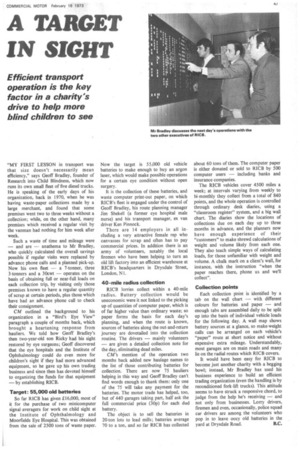A TARGET IN SIGHT
Page 49

If you've noticed an error in this article please click here to report it so we can fix it.
Efficient transport operation is the key factor in a charity's drive to help more blind children to see
"MY FIRST LESSON in transport was that size doesn't necessarily mean efficiency," says Geoff Bradley, founder of Research into Child Blindness, which now runs its own small fleet of five diesel trucks. He is speaking of the early days of his organization, back in 1970, when he was having waste-paper collections made by a large merchant, and found that some premises went two to three weeks without a collection; while, on the other hand, many premises which received a regular visit by the vanman had nothing for him week after week.
Such a waste of time and mileage were — and are — anathema to Mr Bradley, who quickly calculated the overall savings possible if regular visits were replaced by advance phone calls and a planned pick-up. Now his own fleet — a 7-tonner, three 3-tonners and a 30cwt operates on the basis of obtaining full or near-full loads on each collection trip, by visiting only those premises known to have a regular quantity of scrap at certain periods, plus those which have had an advance phone call to check their consignment.
CA/ outlined the background to his organization in a "Bird's Eye View" paragraph a couple of months back, which brought a heartening response from hauliers. We told how Geoff Bradley's then two-year-old son Ricky had his sight restored by eye surgeons; Geoff discovered that the eye hospitals and the Institute of Ophthalmology could do even more for children's sight if they had more advanced equipment, so he gave up his own trading business and since then has devoted himself to organizing the funds for that equipment — by establishing RICB.
Target: 55,000 old batteries So far RICB has given £16,000, most of it for the purchase of two minicomputer signal-averagers for work on child sight at the Institute of Ophthalmology and Moorfields Eye Hospital. This was obtained from the sale of 2500 tons of waste paper. Now the target is 55,000 old vehicle batteries to make enough to buy an argon laser, which would make possible operations for a certain eye condition without open surgery.
It is the collection of these batteries, and waste computer print-out paper, on which RIC B's fleet is engaged under the control of Geoff Bradley, his route planning manager Jim Shekel! (a former eye hospital male nurse) and his transport manager, ex van driver Ken Pinnock.
There are 14 employers in all including a very attractive female rep who canvasses for scrap and often has to pay commercial prices. In addition there is an army of volunteers, notably the local firemen who have been helping to turn an old lift factory into an efficient warehouse at RICB's headquarters in Drysdale Street, London, Ni.
40-mile radius collection RICB lorries collect within a 40-mile radius. Battery collection would be uneconomic were it not linked to the picking up of quantities of computer paper, which is of far higher value than ordinary waste; so paper forms the basis for each day's planning, and when the route is known, sources of batteries along the out-and-return journey are dovetailed into the collection routine. The drivers — mainly volunteers — are given a detailed collection note for the day, eliminating dead miles.
C/14's mention of the operation two months back added new haulage names to the list of those contributing batteries for collection, There are now 75 hauliers helping in this way and Geoff Bradley can't find words enough to thank them: only one of the 75 will take any payment for the batteries. The motor trade has helped, too, but of 440 garages taking part, half ask the full commercial price (30p) for each dud battery.
The object is to sell the batteries in 20-ton lots to lead mills; batteries average 70 to a ton, and so far RICB has collected about 60 tons of them. The computer paper is either donated or sold to RICB by 500 computer users — including banks and insurance companies.
The RICB vehicles cover 4500 miles a week; at intervals varying from weekly to bi-monthly they collect from a total of 840 points, and the whole operation is controlled through ordinary desk diaries, using a "classroom register" system, and a big wall chart. The diaries show the locations of collections due on each day up to three months in advance, and the planners now have enough experience of their "customers" to make shrewd calculations of weight and volume likely from each one. They also teach simple ways of calculating loads, for those unfamiliar with weight and volume. A chalk mark on a client's wall, for instance, with the instruction "when the paper reaches there, phone us and we'll collect".
Collection points Each collection point is identified by a tab on the wall chart — with different colours for batteries and paper — and enough tabs are assembled daily to be split up into the basis of individual vehicle loads for the following day. A wall map shows battery sources at a glance, so make-weight calls can be arranged on each vehicle's "paper" route at short notice and Without expensive extra mileage. Understandably, most garages are on main roads and many lie on the radial routes which RICB covers.
It would have been easy for RICB to become just another charity with a begging bowl; instead, Mr Bradley has used his business experience to build an efficient trading organization (even the handling is by reconditioned fork-lift trucks). This attitude seems to have struck a responsive chord, to judge from the help he's receiving — and not only from businesses. Lorry drivers, firemen and even, occasionally, police squad car drivers are among the volunteers who pop in to leave oozy old batteries in the
yard at Drysdale Road. B.C.












































































































